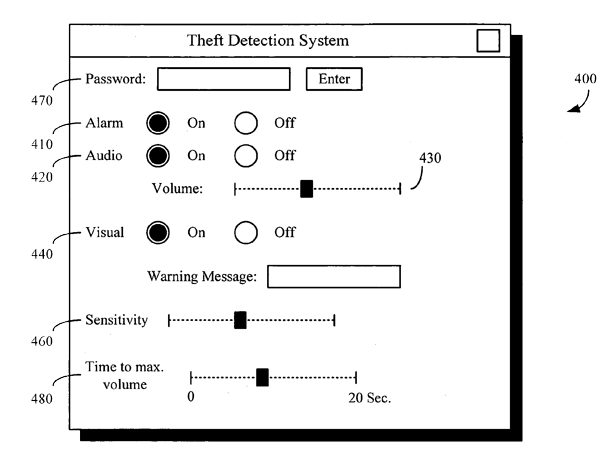Apple Inc. has successfully patented an anti-theft safeguard for notebooks, phones, and other portable electronics that offers protection simply by sensing the outside world.
In the original filing, the company notes that in many cases the theft of a device brings certain movement cues that aren't present for accidental behavior, such as rapid sustained movement. Most unintentional bumps and drops are easy to recognize as sudden stops, it states.
By analyzing the movement of the device over a set amount of time, a device could theoretically tell the difference between a burglar and legitimate users. This would let owners leave their systems alone without a cable lock or other physical security measures while still knowing that sensitive information stored inside would be safe.
Installing an accelerometer and the right software would easily solve the problem, according to the patent. Certain positions or vibration conditions could automatically send a signal to the computer hardware at the heart of the device, forcing it to trigger an audio or video alarm. The device could even be locked entirely and would require a password to return to normal.
One element of the patent observes that software could tune the individual settings, selectively turning on the various warnings or softening the conditions if users trigger the alarm too frequently in everyday use.
A sample interface for controlling the sensor's alarm preferences.
Although Apple has been careful to avoid referencing specific hardware in explaining the mechanism, the California-based firm justifies the invention by pointing out the vulnerability of one of its own devices, to theft — notably, the iPod. Cellphones and notebooks were also cited as obvious targets for thieves and deserving of the breakthrough.
And while no signs have surfaced that would show an imminent use of the motion-sensing technology, the patent draws attention to the appearance of accelerometers in recent — and upcoming — Apple products. The most conspicuous example is the iPhone, which will have an acceleration sensor to auto-rotate the visual interface as the owner tilts the device on its side for media playback.
Macs have also had accelerometers for years. The Sudden Motion Sensor, used first in later PowerBooks and used in MacBooks today, is officially meant to stop the hard disk during a fall but has been used by hobbyists to trigger events within Mac OS X.
No iPods currently feature accelerometers. Apple's only nod to security for the devices has so far been the Screen Lock introduced for the fifth-generation iPod and iPod nano, which hides its controls only through a four-digit combination controlled by the click wheel.
 AppleInsider Staff
AppleInsider Staff







-m.jpg)






 Christine McKee
Christine McKee
 Charles Martin
Charles Martin
 Mike Wuerthele
Mike Wuerthele
 Marko Zivkovic
Marko Zivkovic
 Malcolm Owen
Malcolm Owen


 William Gallagher
William Gallagher

-m.jpg)






24 Comments
I dunno. I think that my PB would think it is being stolen every day with what I put it through...
I think maybe combining it with GPS so the device could think "I'm moving funny and I'm going somewhere different!" would work better.
But I guess I would have to see more about it before deciding that it would be too annoying to use.
Interesting patent.
I think maybe combining it with GPS would work better.
I agree. Not so much automatic detection but even just being able to know where your machine is and it should be embedded deep in the machine so that a thief would literally have to break the machine to get at it. Sensing movement has quite a few problems. One is that just because a person is moving quickly doesn't mean the laptop will be moving erratically if it's padded enough.
This predates iAlertU by over 2 years.
I was thinking it was quite similar, but iAlertU was first released in April 2006.
I agree. Not so much automatic detection but even just being able to know where your machine is and it should be embedded deep in the machine so that a thief would literally have to break the machine to get at it. Sensing movement has quite a few problems. One is that just because a person is moving quickly doesn't mean the laptop will be moving erratically if it's padded enough.
Anyone familiar with Wheels of Zeus (wOz)? Jobs and Woz may be back in business (given the right planetary alignment)!